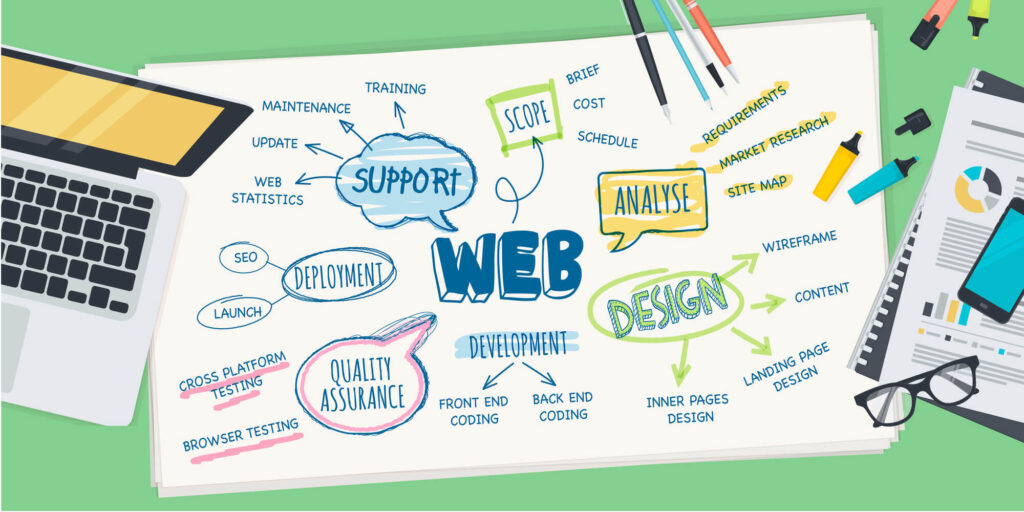In today’s digital age, having a well-designed and functional website is crucial for individuals and businesses alike. Whether you’re starting a blog, promoting a small business, or launching an e-commerce store, planning and creating a website requires careful consideration and attention to detail. This guide will walk you through the essential steps involved in website planning and creation, covering everything from defining your goals and target audience to selecting a platform, designing the layout, and optimizing for search engines. By following this comprehensive guide, you’ll be well-equipped to create an impressive website that effectively meets your objectives.
- Defining Your Goals and Target Audience
Before diving into website creation, it’s essential to define your goals and identify your target audience. Ask yourself what you aim to achieve with your website. Are you looking to provide information, sell products, or generate leads? Understanding your goals will help shape your website’s structure and content. Additionally, defining your target audience will enable you to tailor your design and messaging to resonate with them effectively. Conduct market research and create buyer personas to gain insights into your audience’s demographics, preferences, and behaviors.
- Choosing the Right Platform
Selecting the right platform is a crucial decision in website creation. There are several options available, including content management systems (CMS) like WordPress, website builders like Wix and Squarespace, and custom development. Consider factors such as ease of use, scalability, customization options, and your technical expertise when choosing a platform. CMSs like WordPress offer flexibility and a vast range of plugins, while website builders provide intuitive drag-and-drop interfaces for beginners. For complex projects or unique requirements, custom development may be necessary.
- Planning Your Website Structure
Website structure refers to the organization and hierarchy of pages on your site. A well-structured website is user-friendly and helps visitors navigate easily. Start by creating a sitemap, which outlines the main pages and their relationships. Use categories, subcategories, and menus to organize your content logically. Consider implementing a consistent navigation system that appears on every page, making it easy for users to find what they’re looking for. Pay attention to the user experience (UX), ensuring that the site structure is intuitive and optimized for conversions.
- Designing the Layout and User Interface
An attractive and user-friendly design is crucial for engaging visitors and conveying your brand identity. Begin by choosing a visually appealing color scheme that aligns with your brand. Use typography effectively to enhance readability and hierarchy. Create wireframes or mockups to visualize the layout and structure of each page. Ensure that your design is responsive and optimized for different devices, as an increasing number of users browse the web on mobile devices. Utilize white space effectively to enhance readability and avoid clutter. Incorporate intuitive user interface (UI) elements, such as clear navigation menus, search bars, and prominent call-to-action buttons.
- Creating Compelling Content
Content is king when it comes to attracting and engaging users. Craft compelling and relevant content that aligns with your goals and target audience. Use clear and concise language, and consider employing search engine optimization (SEO) techniques to enhance visibility in search results. Create informative and visually appealing pages, including captivating headlines, well-structured paragraphs, and relevant images or videos. Ensure that your content is well-organized and easy to scan, incorporating headings, bullet points, and subheadings. Regularly update your content to keep it fresh and relevant.
- Optimizing for Search Engines
To increase your website’s visibility and organic traffic, optimize it for search engines. Perform keyword research to identify the terms and phrases your target audience uses when searching for your products or
services. Incorporate these keywords naturally into your content, headings, and meta tags. Pay attention to on-page optimization factors such as meta descriptions, title tags, and alt text for images. Additionally, improve your website’s loading speed, ensure mobile-friendliness, and build high-quality backlinks from reputable websites to boost your search engine rankings.
Conclusion
Website planning and creation require thoughtful consideration of goals, target audience, platform selection, design, content creation, and search engine optimization. By following this comprehensive guide, you’ll be well-prepared to build a successful website that effectively serves your purposes and engages your visitors. Remember to regularly update and improve your website to keep up with evolving trends and user expectations.
To know more about Website Planning And Creation click here
